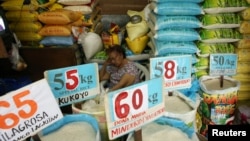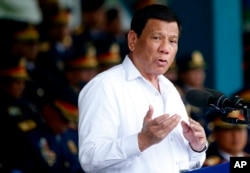As Philippines President Rodrigo Duterte heads into a third year in office, a spike in consumer prices is testing the popularity of the tough-talking leader, who is best known for his deadly anti-drug campaign.
Inflation in the Southeast Asian archipelago rose 6.4 percent in August because of fuel prices, excise taxes and perceptions of a rice shortage, economists and domestic media say. Philippine inflation last month topped the rest of Southeast Asia.
August inflation set a nine-year record the local media outlet Rappler.com said. It exceeded the high end of the government’s monthly forecast of 6.2 percent and its full-year 2018 target of up to 4 percent. It was also higher than elsewhere in Southeast Asia.
Duterte, suddenly the target of anger on social media, has seen his net trust rating fall from 75 to 57 points from December through June.
Domestic problems
“He’s facing a lot of problems domestically with inflation and problems with rice and other things,” said Maria Ela Atienza, a political science professor at University of the Philippines Diliman.
Duterte made a name internationally after taking office in 2016 for a deadly anti-drug campaign, unusually tight relations with China and a rough manner of speaking.
Inflation has sparked a “loss of consumer confidence,” said Carl Baker, director of programs with the think tank Pacific Forum CSIS in Honolulu. “I think it is still too early to tell if this is going to be a long-term problem or if he can find a way to regain control of the inflation cycle or at least distract people from its impacts,” he said.
Price-sensitive consumers
Rice, as well as vegetables and bottled drinks, all cost more this year. In Manila, rice is selling at 55 pesos ($1) per kilogram, up from the 39 that Jerichson Gomez is used to paying. The 35-year-old security guard can afford that as well as excise taxes on other goods, but expects a remedy such as more rice imports.
“Every week the rice is high,” Gomez said. “And vegetables, gasoline, very high. The excise tax is high, all beverages, cigarettes, every year it’s high.”
Some of his fellow citizens rely on discounted rice from the government or eat less, according to media reports.
A perceived rice shortage in parts of the south prompted one city, Zamboanga, to declare a state of calamity. The Philippine agriculture secretary suggested legalizing smuggled supplies as an offset, one local media report says, but the president rejected the idea. Rice prices in Zamboanga had risen about 75 percent, the report said.
Price of fuel
Inflation hit the Philippines because of domestic excise taxes, weakness of the peso currency and rising prices of commodities such as fuel, said Jonathan Ravelas, chief market strategist with Banco de Oro UniBank in Metro Manila.
The Philippines has few of its own energy sources, leaving it particularly vulnerable to world price fluctuations such as a 14 percent increase in fuel prices from April through June.
Tax reform aimed at reducing poverty to 14 percent from 21.6 percent by 2022 has amplified inflation, Ravelas said. Fuel and cars are subject to the taxes.
“I think it just got out of hand,” he said. “Other nations in the region are also trying to battle inflation. It’s just that in Philippines it just went more exaggerated.”
Shaken trust ratings
Duterte received a 65-point net trust rating in the first quarter of 2018 from the Metro Manila-based research institution Social Weather Station, down from 75 points in 2017. In the second quarter his rating dropped to 57 points.
A president’s popularity normally goes down around this stage of a presidency as people expect “concrete results,” Atienza said. The anti-drug campaign, popular with urban Filipinos who felt their neighborhoods were getting safer, had helped Duterte buoy trust ratings from his inauguration in mid-June through 2017.
Pollsters have not released data for August, Atienza cautioned.
“We have not really factored in yet the issue about soaring prices of fish and other commodities and inflation,” she said.
Presidential response
Through the presidential website, Duterte said his administration was “working to ease the burden of the public” over rising prices of “essential commodities.” But he rejected claims of a rice shortage, adding that “some people are controlling the supply.”
On a trip to Israel earlier in the month, he told Filipinos there that his country had excess rice, enough to export.
Inflation is probably near its peak, Ravelas said. He forecasts 4.9 percent inflation for 2018 as a whole as prices normalize.









